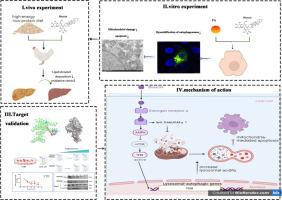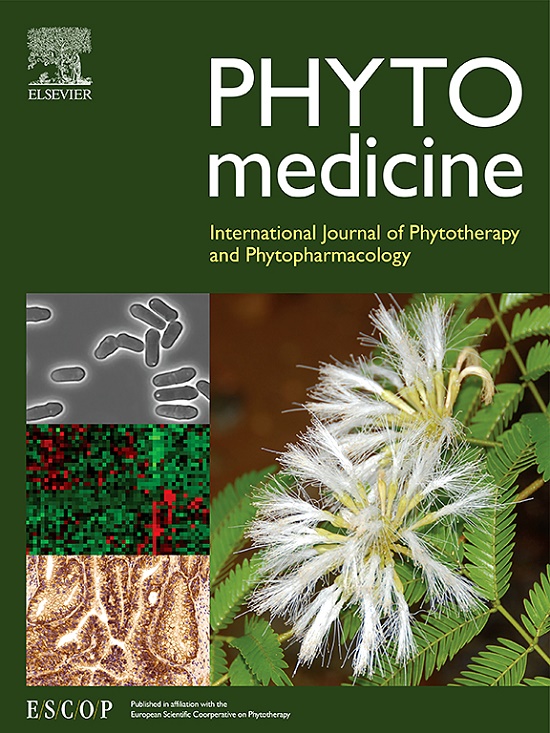薯蓣皂苷通过促进ERα-AMPK介导的蛋鸡有丝分裂来改善脂肪肝出血性综合征。
IF 6.7
1区 医学
Q1 CHEMISTRY, MEDICINAL
引用次数: 0
摘要
背景:线粒体在维持代谢平衡方面发挥着至关重要的作用。线粒体损伤与脂肪肝出血综合征(FLHS)的发病机制密切相关,而有丝分裂是消除受损线粒体的最有效方法之一。目的:我们探讨了迪奥霉素对蛋鸡高能低蛋白(HELP)日粮诱导的脂肪肝的影响,主要集中在迪奥霉素对线粒体损伤的保护作用上:为了研究地奥司钦对蛋鸡脂肪肝综合征的影响,我们首先给蛋鸡饲喂高能量低蛋白日粮,诱发蛋鸡脂肪肝综合征。然后,我们使用油红染色法和商用检测试剂盒评估脂质代谢相关指标。此外,通过评估肝细胞脂肪沉积和肝细胞凋亡的激活情况,证实了地奥辛对蛋鸡脂肪肝综合征的作用;并通过体外 LMH 细胞实验研究了地奥辛在蛋鸡脂肪肝综合征中的作用机制。此外,还进行了CETSA和分子对接以进一步证实:结果表明,地奥司钦可减轻线粒体损伤,缓解HELP日粮引起的肝脏脂滴过度沉积和氧化应激。此外,地奥司钦通过激活雌激素受体α(ERα)/腺苷酸-5'-单磷酸激活蛋白激酶(AMPK)信号通路来调节有丝分裂,从而减轻线粒体损伤和肝细胞凋亡。此外,我们还发现地奥辛通过激活ERα-AMPK信号通路,促进核转录因子向细胞核内转位,从而促进蛋鸡肝脏和LMH细胞的自噬通路。此外,用溶酶体酸化抑制剂巴佛洛霉素 A1 预处理细胞可阻断地奥辛对棕榈酸(PA)刺激 LMH 细胞诱导的细胞凋亡的抑制作用,这表明地奥辛通过激活有丝分裂来减少 PA 诱导的细胞凋亡。此外,在使用ERα特异性抑制剂甲基哌啶基吡唑预处理的PA诱导的LMH细胞中,迪奥霉素诱导的溶酶体酸化和线粒体生物生成被逆转:本研究首次证明,迪奥霉素可减轻 HELP 日粮诱导的蛋鸡脂肪肝综合征。研究结果表明,地奥司钦在减少线粒体损伤和细胞凋亡方面发挥了重要作用,而这些有益作用主要是通过促进ERα-AMPK信号传导来实现的。这些发现为考虑将地奥辛作为减轻蛋鸡FLHS的一种可能的治疗方案提供了理论依据。本文章由计算机程序翻译,如有差异,请以英文原文为准。

Dioscin improves fatty liver hemorrhagic syndrome by promoting ERα-AMPK mediated mitophagy in laying hens
Background
Mitochondria play a crucial role in upholding metabolic homeostasis. Mitochondrial damage closely associated with the pathogenesis of fatty liver hemorrhagic syndrome (FLHS), while mitophagy being among the most effective methods for eliminating the damaged mitochondria. Dioscin, a natural extract, can activate autophagy; however, its effects on FLHS regarding mitophagy regulation remain unelucidated.
Purpose
We explored the impact of dioscin on FLHS induced by a high-energy and low-protein (HELP) diet in laying hens, mainly focused the protective effects of dioscin on mitochondrial injury.
Method
To investigate the impact of dioscin on fatty liver syndrome in laying hens, we first induced the condition by feeding them a high-energy and low-protein diet. Then, we assessed lipid metabolism-related markers using oil red staining and a commercial detection kit. In addition, the role of dioscin on fatty liver syndrome in laying hens was confirmed by assessing the activation of hepatocyte fat deposition and hepatocyte apoptosis; and the mechanism of dioscin in FLHS was investigated through LMH cell experiment in vitro. Furthermore, CETSA and molecular docking were conducted for additional confirmation.
Result
The results showed that dioscin alleviated mitochondrial damage, relieved the excessive deposition of hepatic lipid droplets and oxidative stress induced by HELP diet in laying hens. Furthermore, dioscin regulated the mitophagy by activating the estrogen receptor α (ERα)/adenosine 5′-monophosphate-activated protein kinase (AMPK) signaling pathway, thus mitigating mitochondria injury and apoptosis in hepatocytes. In addition, we found that dioscin promoted the translocation of nuclear transcription factor into nucleus by activating ERα-AMPK signaling, facilitating autophagic flux in the liver of laying hens and LMH cells. Furthermore, cells pretreated with the lysosomal acidification inhibitor bafilomycin A1 blocked the inhibitory effect of dioscin on the apoptosis induced by palmitic acid (PA)-stimulation in LMH cells, suggesting that dioscin reduces PA-induced apoptosis by activating mitophagy. Moreover, dioscin-induced lysosomal acidification and mitochondrial biogenesis were reversed in PA-induced LMH cells pretreated with ERα-specific inhibitor methylpiperidino pyrazole.
Conclusion
This study firstly demonstrated that dioscin alleviates fatty liver syndrome induced by HELP diet in laying hens. The findings from this study illustrated that dioscin plays a significant role in reducing mitochondrial damage and apoptosis, and these beneficial effects mainly achieve through promotion of ERα-AMPK signaling, which mediates autophagy within the liver of laying hens fed a HELP-diets. These findings provide a theoretical basis for considering dioscin as a possible treatment option for mitigating FLHS in egg-laying hens.
求助全文
通过发布文献求助,成功后即可免费获取论文全文。
去求助
来源期刊

Phytomedicine
医学-药学
CiteScore
10.30
自引率
5.10%
发文量
670
审稿时长
91 days
期刊介绍:
Phytomedicine is a therapy-oriented journal that publishes innovative studies on the efficacy, safety, quality, and mechanisms of action of specified plant extracts, phytopharmaceuticals, and their isolated constituents. This includes clinical, pharmacological, pharmacokinetic, and toxicological studies of herbal medicinal products, preparations, and purified compounds with defined and consistent quality, ensuring reproducible pharmacological activity. Founded in 1994, Phytomedicine aims to focus and stimulate research in this field and establish internationally accepted scientific standards for pharmacological studies, proof of clinical efficacy, and safety of phytomedicines.
 求助内容:
求助内容: 应助结果提醒方式:
应助结果提醒方式:


